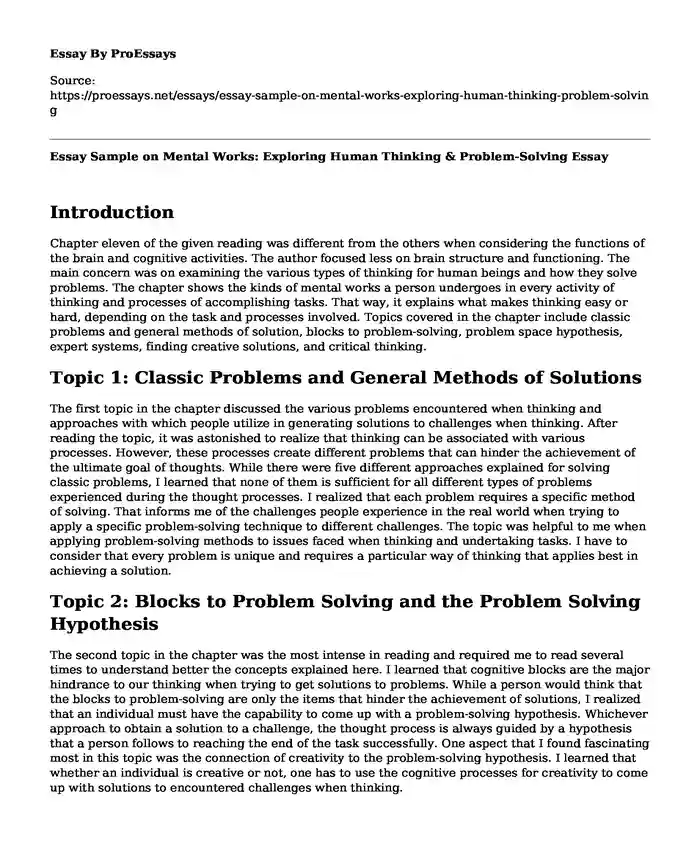Introduction
Chapter eleven of the given reading was different from the others when considering the functions of the brain and cognitive activities. The author focused less on brain structure and functioning. The main concern was on examining the various types of thinking for human beings and how they solve problems. The chapter shows the kinds of mental works a person undergoes in every activity of thinking and processes of accomplishing tasks. That way, it explains what makes thinking easy or hard, depending on the task and processes involved. Topics covered in the chapter include classic problems and general methods of solution, blocks to problem-solving, problem space hypothesis, expert systems, finding creative solutions, and critical thinking.
Topic 1: Classic Problems and General Methods of Solutions
The first topic in the chapter discussed the various problems encountered when thinking and approaches with which people utilize in generating solutions to challenges when thinking. After reading the topic, it was astonished to realize that thinking can be associated with various processes. However, these processes create different problems that can hinder the achievement of the ultimate goal of thoughts. While there were five different approaches explained for solving classic problems, I learned that none of them is sufficient for all different types of problems experienced during the thought processes. I realized that each problem requires a specific method of solving. That informs me of the challenges people experience in the real world when trying to apply a specific problem-solving technique to different challenges. The topic was helpful to me when applying problem-solving methods to issues faced when thinking and undertaking tasks. I have to consider that every problem is unique and requires a particular way of thinking that applies best in achieving a solution.
Topic 2: Blocks to Problem Solving and the Problem Solving Hypothesis
The second topic in the chapter was the most intense in reading and required me to read several times to understand better the concepts explained here. I learned that cognitive blocks are the major hindrance to our thinking when trying to get solutions to problems. While a person would think that the blocks to problem-solving are only the items that hinder the achievement of solutions, I realized that an individual must have the capability to come up with a problem-solving hypothesis. Whichever approach to obtain a solution to a challenge, the thought process is always guided by a hypothesis that a person follows to reaching the end of the task successfully. One aspect that I found fascinating most in this topic was the connection of creativity to the problem-solving hypothesis. I learned that whether an individual is creative or not, one has to use the cognitive processes for creativity to come up with solutions to encountered challenges when thinking.
Topic 3: Finding Creative Solutions
The third topic in the chapter was interesting. It connected with the need of expert knowledge as well as creativity in the subject of thinking and problem-solving. What I realized crucial in finding creative solutions was the aspect of critical thinking. After reading the process and blocks to problem-solving, it was easy for me to connect other expert systems and critical thinking elements. I think the author explained well the need for expertise when considering the achievement of creative solutions. Expertise gives a person the knowledge of something, then utilize that knowledge in finding the answer to a given task. The topic helped me reflect on the application of the problem-solving hypothesis in finding creative solutions that require a step-by-step process of thinking and undertaking tasks to arrive at the ultimate solution.
Conclusion
In conclusion, the eleventh chapter of the given reading was useful for learning more about the cognitive processes of thinking and problem-solving. I learned that the two elements are connected and depend on the other for the effective thought process. I would recommend any person handing challenging tasks to read the topic on thinking and problem solving to gain crucial cognitive skills such as using the problem space hypothesis to handle blocks to problem-solving as well as critical thinking in finding creative solutions.
Reference
Galotti, K. (2017). Cognitive psychology in and out of the laboratory. 6th Edition. Sage Publications, Inc. ISBN13: 9781506351568
Cite this page
Essay Sample on Mental Works: Exploring Human Thinking & Problem-Solving. (2023, Sep 17). Retrieved from https://proessays.net/essays/essay-sample-on-mental-works-exploring-human-thinking-problem-solving
If you are the original author of this essay and no longer wish to have it published on the ProEssays website, please click below to request its removal:
- A General Overview of the Importance of Fire and Life Safety Education
- Paper Example on Effective Online Business Strategies in the Area of E-Commerce
- The Motivation of Successful People Essay Example
- Marriott International Company Analysis Paper Example
- Understanding Autism Spectrum Disorder (ASD): Causes, Symptoms & Treatment - Research Paper
- Risk Management: Navigating Uncertainty in the Evolving Business Environment - Essay Sample
- Nurse Self-Growth: Achieving the Best Self for Quality Care - Essay Sample







